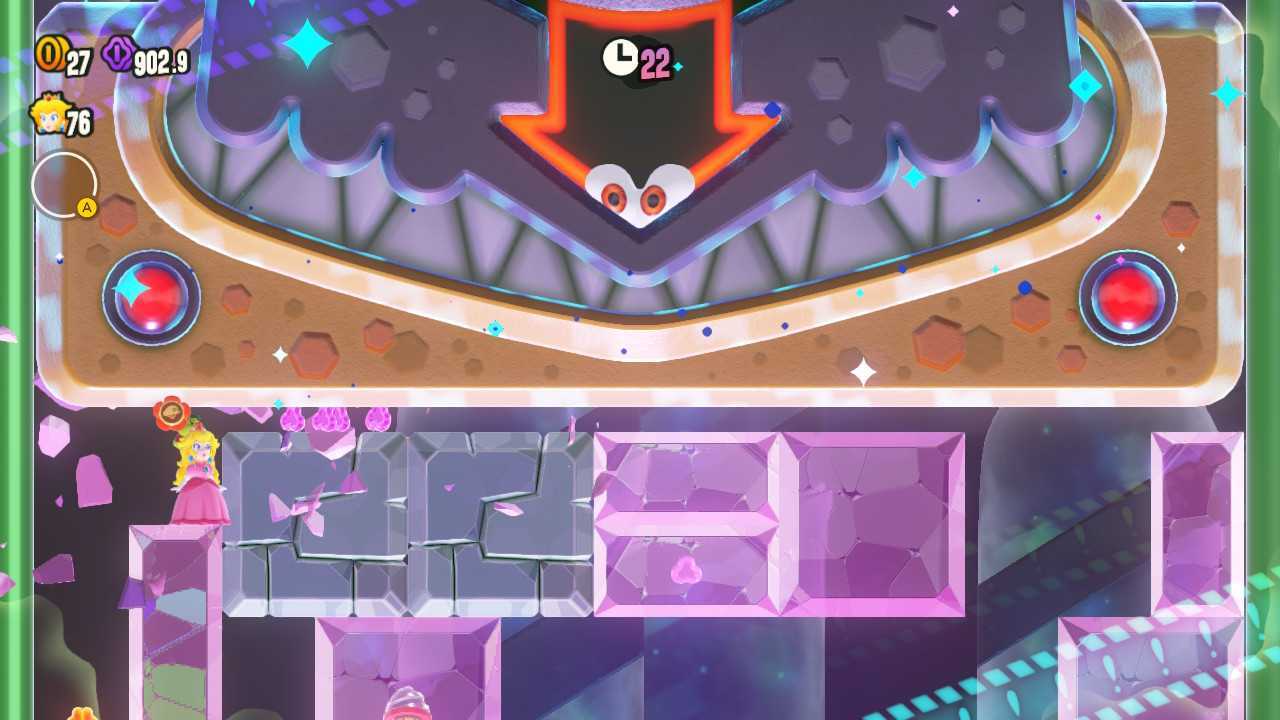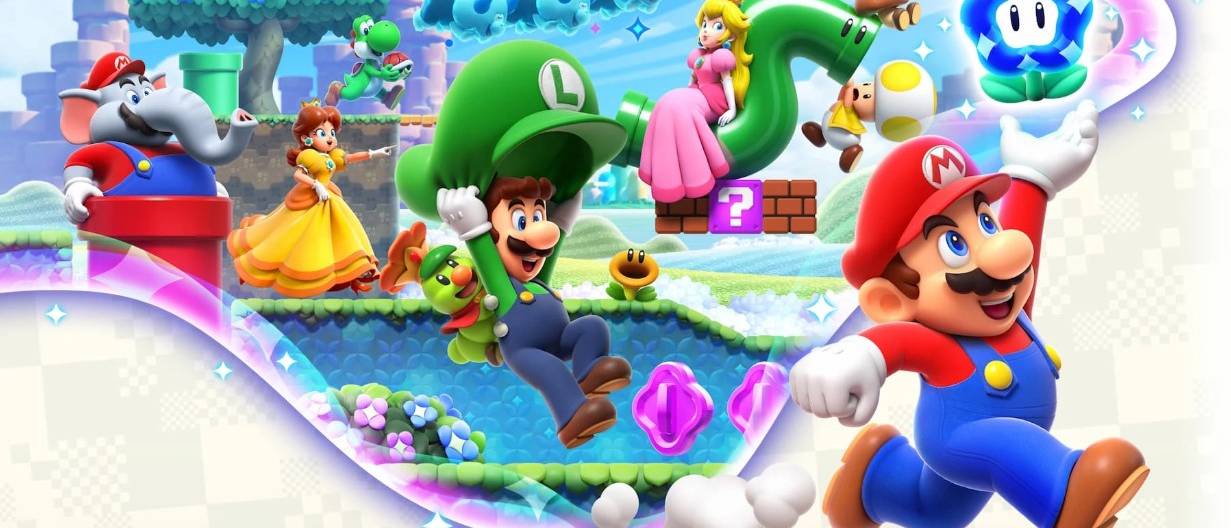TechRadar Verdict
Super Mario Bros. Wonder is a triumphant evolution of 2D Mario, with a non-stop flow of creative ideas wrapped up in a visually delightful package, bursting with character.
Pros
- +
Exciting, varied levels with a wide difficulty scale
- +
Gorgeous visuals with small, meaningful details
- +
Levels and worlds are full of satisfying secrets to find
Cons
- -
Removal of the triple and double jump is limiting
- -
‘Easy mode’ options shouldn’t be limited to specific characters
Why you can trust TechRadar
Platform reviewed: Nintendo Switch
Available on: Nintendo Switch
Release date: October 20, 2023
Playing Super Mario Bros. Wonder reminded me what video games are all about: having fun. Nintendo’s latest side-scrolling platformer has refined and built upon the 2D Mario installments that came before it, adding an onslaught of original, creative ideas that never feel old, loads of secrets to uncover, visuals that pop, and tiny details that are a genuine joy to spot.
From start to finish, Super Mario Bros. Wonder is a delight. With this new Nintendo Switch release, the developers have been afforded more creativity than ever before when it comes to spicing up the numerous levels for Mario and his friends to traverse, thanks to the inclusion of the titular Wonder Effects. Triggered by finding a Wonder Flower in a course, these are weird and wonderful events that can alter the very way that a level is played and make each one a truly memorable experience.
Some Wonder Effects offer an additional amount of challenge, others are a visual spectacle to behold, and others exist seemingly with the sole purpose of making players smile. I wrote in my extended preview that I’ve never played a game that’s made me smile as fast as Super Mario Bros. Wonder, and now that I’ve completed it, I can confirm that I never stopped smiling throughout my time with the game, with the Wonder Effects being one of the main reasons why. Of course, discovering these firsthand is a massive part of the fun, so I won’t go into specifics here beyond what I discussed in my preview, but needless to say, they’re so much more than a simple gimmick, but an intrinsic yet eccentric part of the experience.

After I thought I’d finished the game, I revisited one of the worlds and found a hidden area that I’d completely missed the first time around and had the thrilling realization that I had plenty more to explore.
More intrinsic still is Wonder’s overall charm, which goes far beyond its bright, colorful coat of paint. Everyone and everything is so expressive: characters’ hats are seen almost flying off their heads when they plummet down gaps, their gaze grows more determined as they shift from a gentle stroll to a faster sprint, and Goombas look up in fear as they see you about to land on their heads. Certain details are hidden in the game’s music and sound effects, too: ground pounds are preceded by drum rolls, and background tracks lower in pitch when someone transforms into their chunky elephant form using an Elephant power-up. There are too many to list here, but all of these things contribute to Wonder feeling like the liveliest 2D Mario game to date - it feels like walking into a side-scrolling version of The Super Mario Bros. Movie.
Badge of honor

Super Mario Bros. Wonder doesn’t rely solely on Wonder Effects to spice up its platforming experience - the addition of Badges is an enormous deal for replayability, accessibility, and accommodating differing playstyles. There are numerous to unlock throughout the game, and they’re divided into three categories - Action, Boost, and Expert - and one can be equipped at a time.
Boost Badges include the Auto Super Mushroom and Safety Bounce Badges - the first of which transforms player characters into their larger ‘Super’ forms at the start of each level (or each time they respawn), while the latter prevents them from dying by falling down pits or into lava. Elsewhere, Expert Badges such as Jet Run (which forces players to zoom forward without stopping) and Invisibility (you’ll never guess what that one does) exist to provide an extra challenge for anyone who dares take them on.
Action Badges, like the self-explanatory Crouching High Jump and Parachute Cap Badges, give players new movement options which they can utilize at any point, giving Mario and his buddies new ways to run, leap, and soar. While none are required to access areas in any of the ‘regular’ levels (more on that shortly), they can make certain maneuvers easier, and it’s fantastic fun to explore stages in different ways by using alternate abilities. The feeling is almost akin to playing 3D Mario titles such as Odyssey, in which talented players can parkour and catapult themselves pretty much wherever they please with enough practice.
Sign up for breaking news, reviews, opinion, top tech deals, and more.
I imagine that experimenting with Action Badges will be popular in the speedrunning community, although it’s worth noting that the double and triple jump, previously included in past Mario games as built-in special moves, aren’t present in Wonder. This is a pity, as being able to combo these special jumps into Action Badges would have added even more possibilities for free-flowing action.
Secrets, spice, and all things nice

Even if you’re not too bothered about mixing and matching the Badges you use during the majority of the game, Badge Challenge levels provide a short but sweet outlet to test your skills and learn the quirks of each ability in stages that are purpose-built to make use of them. These levels, alongside the bite-size ‘Break Time!’ stages (one of which, for example, has you knock out a few Piranha Plants on musical note blocks, before playing a nostalgic Mario tune) break up the longer regular stages nicely and help add even more variety to Wonder’s vast array of action.
While some stages unlock in a linear manner, many can be accessed in any order in free-roam sections. Not only is this brilliant for the simple matter of being able to choose what sequence to play them in (which is a relief, as some are genuinely difficult), but these parts of the map can be home to secret areas and levels, encouraging players to investigate every last inch of the overworld. Secrets exist within courses, too - alternative exits and paths can be found in several levels, meaning there’s a great deal of replayability for anyone who wants to discover everything.
In case it wasn’t already abundantly clear, I adore Super Mario Bros. Wonder. Not only does it wholeheartedly feel like an innovative rebirth for 2D Mario, but it can’t be overstated how well-polished it is. As well as the adorable and amusing subtleties that populate every pixel and exude personality, the controls are responsive, everything runs smoothly even when the action gets chaotic, and in my time playing, I didn’t encounter any bugs or glitches. Although not an absolute necessity for enjoyment, Wonder looks stunning on the Nintendo Switch OLED, with the console’s screen suited to making vivid colors pop.
While I’ve completed literally everything that the game has to offer, I can’t stop thinking about Super Mario Bros. Wonder. It’s impossible to imagine it being anything but a must-play title for any Nintendo Switch owner - particularly for anyone who grew tired of the repetitive 2D New Super Mario Bros. series. If you like feeling happy, you’ll love Super Mario Bros. Wonder.
Accessibility features

Super Mario Bros. Wonder offers plenty of features for a more accessible experience. Controls can be adjusted, allowing players to swap the buttons used to jump and run, and controller vibration can be strengthened and weakened.
Of the 12 playable characters, Nabbit and the Yoshis are immune to damage, meaning that anyone can switch to them if they’re having trouble with a level. It does feel unfortunate, however, that this damage immunity can’t be applied to all characters, or removed from Yoshi and Nabbit if fans of the characters want to play without the additional feature.
The aforementioned Boost Badges, such as the Auto Super Mushroom Badge and Safety Bounce badge, are also very helpful in providing support to players as and when they need it. However, it’s worth noting that Badges must be unlocked, so they’re not all available right from the start of the game.
Elsewhere, Talking Flowers can speak in 15 different languages, and their dialogue is automatically subtitled - they can be adjusted to speak without subtitles, or just via in-game text.
How we reviewed
I spent around 27 hours playing Super Mario Bros. Wonder to 100% completion. It took me roughly 17 hours to finish the main story, but it could be done faster if players are less focused on finding all the collectibles and hidden levels. I played on a Nintendo Switch OLED model, in a mix of handheld and TV modes.
For more Nintendo goodness, be sure to check out our list of the best Nintendo Switch games. You can also read our roundup of upcoming Switch games releasing in 2023 and beyond.

Catherine is a News Writer for TechRadar Gaming. Armed with a journalism degree from The University of Sheffield, she was sucked into the games media industry after spending far too much time on her university newspaper writing about Pokémon and cool indie games, and realising that was a very cool job, actually. She previously spent 19 months working at GAMINGbible as a full-time journalist. She loves all things Nintendo, and will never stop talking about Xenoblade Chronicles.
